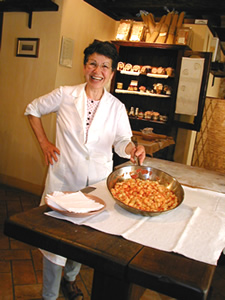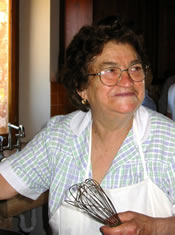|

by
Susan Van Allen
Photos by Bill Sutherland
Experience the Best Cuisine in Tuscan, Italy
 |
|
Bruna
Giannini, a Montefollonico village nonna who teaches
"Tuscan Women Cook".
|
I
leaned in to inhale one of my favorite smells on earth - garlic
simmering in extra virgin olive oil. On the other burners stuffed
zucchini blossoms cooked with ripe red tomatoes next to a pot
where dark green chard and carrots bubbled. Into the picture
came the thick, gnarled hand of my cooking teacher holding a
wooden spoon.
On
the counter, the morning sun cast a glow over a round of aged
pecorino cheese which sat in front of a bottle of ruby Vino
Nobile di Montepulciano… I'd landed smack in the midst
of a Tuscan culinary masterpiece.
The
program I enrolled in last June, "Tuscan Women Cook,"
included a week of cooking lessons, trips to nearby towns,
wineries, markets, cheese factories, restaurants, and designer
outlet shops. It was centered in the 13th century village
of Montefollonico (population 700), an hour south of Florence,
where rolling hills of olive groves and young vineyards in
the Chiana Valley presented a landscape right out of the Florence
galleries. But instead of standing back and admiring Tuscany
as a tourist in a museum, on this trip I stepped inside it,
sharing the tastes of it with the locals, transplants, and
tourists who filled it.
A
passion for Tuscan food and wine was our bond. Eight American
visitors eagerly gathered to eat and drink the regional specialties,
and learn how they were made. Our hosts were Bill and Patty
Sutherland, transplanted Texans, who had fallen in love with
the area through many visits. Five years ago they left Dallas,
bought a hilltop Montefollonico farmhouse, and settled in
to pursue their "Under The Tuscan Sun" dream.
They
hired Iolanda and Bruna, two village nonnas, who on alternate
days taught in the Sutherland's renovated kitchen. The choice
to hire town women instead of star chefs makes this cooking
school unique -- no Emeril "BAM!" showmanship here.
The morning classes were like family parties where we'd hang
out with grandma and Cristina (the local pharmacist's daughter)
who acted as translator.
Each
instructor had an individual, endearing style, showing us
traditional dishes they'd been making since they were kids.
Bruna, trim and crisp, wowed me with her pasta making. She'd
flip a sheet of dough off a wooden roller or twirl gnocchi
off a fork to make perfect tiny ridges. Then she'd stand back
and pose for our cameras, a demure magician.
 |
Iolanda
Marcocci. |
Iolanda,
five feet tall and stocky with a low gravely voice and swollen
ankles that spilled over her orthopedic shoes, had a more
rough-around-the-edges manner. She prowled from table to stove
fully in charge, brandishing her wooden spoon or old paring
knife she called "mi amore." She treated Bill and
Patty like her own children - one minute scolding them for
buying ricotta that wasn't up to her standards, the next pinching
their cheeks with affection.
"Will
you adopt me?" one of the students asked, after tasting
Iolanda's ribolitta, a hearty vegetable soup. Without missing
a beat, Iolanda lit up and answered with a vigorous, "Si!"
The
country cooking centered on simplicity. Olive oil and sea
salt were used liberally; vinegars, herbs, and sauces were
added with a light touch so the flavors of fresh tomatoes,
rich mushrooms, and homemade pasta weren't overwhelmed. And
no fancy Williams Sonoma tools here. Iolanda and Bruna used
their expert hands as food processors - breaking up tomatoes
for sauce, tearing herbs for salad, and mixing dough.
Bill
encouraged us to "jump in and give a hand" during
the pasta making, but my attempt at rolling pici, the thick
spaghetti specialty of the region, resulted in a lumpy mess.
As I stood back and watched Iolanda smush up and perfectly
re-roll the dough on her mother's old pine board, I realized
"jumping in and giving her a hand" is like
me grabbing Michelangelo's chisel and giving a hand with
the David.
Patty
set the table with linens from the Arezzo antique market and
sprigs of lavender from their yard. With a CD of Andrea Bocelli
(also a Tuscan native) serenading us and Bill pouring the
wine, we'd dig into the four-course lunch we'd been salivating
over during class. The week's highlights for me were Bruna's
tagliatelle with cinghiale (wild boar) sauce and Iolanda's
creamy tiramisu.
Dinners
stretched late into the warm evenings, showcasing a range
of local restaurants and chefs. In each, the bounty of local farmlands was transformed into flavorful dishes - from
simple grilled chiana beef to rich duck spiced with wild fennel.
And as our own class party continued, we got to know more
of Montefollonico's natives.
At
the elegant Michelin starred La Chuisa, (a converted olive
press), I slipped back to the kitchen to thank chef Dania
Lucherini, who'd bowled us over with a seven-course feast.
There
she was, a tall willowy blonde, stirring tomato sauce with
one hand and tilting a glass of prosecco to her lips with
the other. She purred like an Italian movie starlet, "I
am so happy you come visit me."
At
Il Botteghino, a rambling old house turned trattoria, we blended
in with the packed scene on the porch. A chorus of "Buon
Compleanno" (Happy Birthday) burst from a family table
inside, as next to us a very much in love young couple stared
into each other's eyes while devouring a thin crusted pizza.
"This
is the town truck stop," Bill joked. For me, it was authentic
Italian country living at its robust finest.
On
Hotel La Costa's terrace, chef Paolo Masini, (following in
the footsteps of his grandfather who was the royal cook in
Naples), sent out intensely flavored black-olive bruschetta,
as we took in the breathtaking sunset. Cypress trees and blooming
yellow finestra dotted the young vineyards and farmlands.
Cortona, the hills of Umbria and Lake Trasimeno faded in the
distance as we wined and dined till two in the morning.
The
terrace was set over Montefollonico's wall which, in Medieval
times, had served as protection from the nearby Montepulciano
Guelph warriors. It could not have been a more peaceful spot
now; nor more perfect for our accommodations. Our rooms were
upstairs in the attached historical landmark building, that
had once been the town farm.
The
only drawback to the beauty of Montefollonico life was that
it made the trips to Pienza, Montepulciano, and the designer
factory outlets pale in comparison. Sure there were church
frescoes to be admired and an astounding variety of pecorino
cheeses, Vino Nobile and Brunello wines to buy. And it was
a kick to go elbow to elbow with the stylish Italians at the
Prada store and score a chic pair of flats I'd seen for double
the price in Los Angeles.
But
it always felt best to drive back under the stone arch to
Montefollonico. After only a few days the faces in the two-via
village became familiar: the signoras in housecoats and gold
jewelry sets who sat on the bench in the piazza and gave us
cordial buona seras… the boys kicking soccer balls
across the cobblestones… the priest who weeded the church
garden, rang the bells, and then threw on a vestment to say
mass.
I
grew so attached to the spot I stayed on a few days after
my classmates left. Wandering around at lunchtime, I passed
Iolanda's house and peeked in to discover her unloading bags
from her morning shopping. The next thing I knew, she'd pulled
me into her kitchen and sat me at the table with her husband,
Novilo, whom she'd called in from pruning their backyard grape
arbor.
Novilo
poured Chianti from a jug as Iolanda bustled about, frying
up zucchini blossoms, slicing up fresh bread and setting it
before me next to a bowl of deep green olive oil. I took a
deep breath, feeling part of the family… and preparing
for my next taste of yet another Tuscan culinary masterpiece.
IF
YOU GO.... |
Tuscan
Women Cook,
Bill and Patty Sutherland,
Podere Poggio Castagni
53040 Montefollonico (SI), Italy,
(T) 011-39-0577-669444,
(F) 011-39-0577-668707, www.tuscanwomencook.com |
|